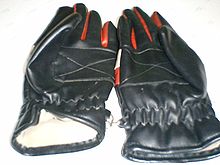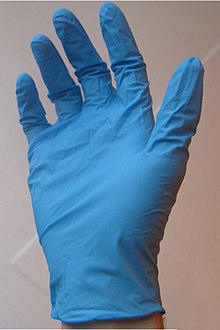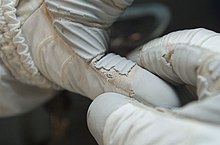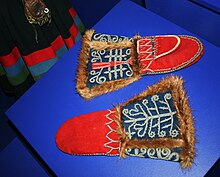Glove: Difference between revisions
→In popular Culture: Section created |
|||
| Line 144: | Line 144: | ||
* Intermediate - Gloves that don't fit into minimal risk or complex design categories. |
* Intermediate - Gloves that don't fit into minimal risk or complex design categories. |
||
[[Image:Goalkeeperglove pano FCB981.jpg|thumb|400px|center|A footballer's [[Goalkeeper glove]] from different angles]] |
[[Image:Goalkeeperglove pano FCB981.jpg|thumb|400px|center|A footballer's [[Goalkeeper glove]] from different angles]] |
||
== In popular culture == |
|||
{{In popular culture|date=September 2010}} |
|||
There are various official Guinness World Records linked to gloves. |
|||
New Zealander Alastair Galpin set the following Guinness World Records: |
|||
* "Most gloves worn on one hand" (24) - set in 2008. <ref>[http://www.worldrecordchase.com/records-stories/most-gloves-worn-on-one-hand2008.html World Record for Most gloves worn on one hand]</ref> |
|||
* "Most gloves put on one hand in one minute" (10) - set in 2009. <ref>[http://www.worldrecordchase.com/achieved-records.html World Record for Most gloves put on one hand in one minute]</ref> |
|||
==References== |
==References== |
||
Revision as of 12:53, 7 September 2010
It has been suggested that Leather glove be merged into this article. (Discuss) Proposed since August 2010. |


A glove (Middle English from Old English glof) is a garment covering the hand. Gloves have separate sheaths or openings for each finger and the thumb; if there is an opening but no covering sheath for each finger they are called "fingerless gloves". Fingerless gloves with one large opening rather than individual openings for each finger are sometimes called gauntlets. Gloves which cover the entire hand but do not have separate finger openings or sheaths are called mittens. Mittens are warmer than gloves made of the same material because fingers maintain their warmth better when they are in contact with each other. Reduced surface area reduces heat loss.
A hybrid of glove and mitten which contains open-ended sheaths for the four fingers (as in a fingerless glove, but not the thumb) and also an additional compartment encapsulating the four fingers as a mitten would. This compartment can be lifted off the fingers and folded back to allow the individual fingers ease of movement and access while the hand remains covered. The usual design is for the mitten cavity to be stitched onto the back of the fingerless glove only, allowing it to be flipped over (normally held back by Velcro or a button) to transform the garment from a mitten to a glove. These hybrids are called convertible mittens or glittens, a combination of "glove" and "mittens".
Gloves protect and comfort hands against cold or heat, damage by friction, abrasion or chemicals, and disease; or in turn to provide a guard for what a bare hand should not touch. Latex, nitrile rubber or vinyl disposable gloves are often worn by health care professionals as hygiene and contamination protection measures. Police officers often wear them to work in crime scenes to prevent destroying evidence in the scene. Many criminals wear gloves to avoid leaving fingerprints, which makes the crime investigation more difficult. However, not all gloves prevent fingerprints from being left on the crime scene, depending on the material from which the glove is made.[1]
Fingerless gloves are useful where dexterity is required that gloves would restrict. Cigarette smokers and church organists use fingerless gloves. Some gloves include a gauntlet that extends partway up the arm. Cycling gloves for road racing or touring are usually fingerless, as are sailing gloves.
Gloves are made of materials including cloth, knitted or felted wool, leather, rubber, latex, neoprene, and metal (as in mail). Gloves of kevlar protect the wearer from cuts. Gloves and gauntlets are integral components of pressure suits and spacesuits such as the Apollo/Skylab A7L which went to the moon. Spacesuit gloves combine toughness and environmental protection with a degree of sensitivity and flexibility.
Expensive women's fashion gloves are made in France, Canada and other countries. For cheaper male gloves New York State, especially Gloversville, New York is a center of glove manufacturing. More and more glove manufacturing is being done in East Asia, however.
History

Gloves appear to be of great antiquity. According to some translations of Homer's The Odyssey, Laërtes is described as wearing gloves while walking in his garden so as to avoid the brambles.[2] (Other translations, however, insist that Laertes pulled his long sleeves over his hands.) Herodotus, in The History of Herodotus (440 BC), tells how Leotychides was incriminated by a glove (gauntlet) full of silver that he received as a bribe.[3] Among the Romans also there are occasional references to the use of gloves. According to Pliny the Younger (ca. 100), his uncle's shorthand writer wore gloves during the winter so as not to impede the elder Pliny's work.[4]
During the 13th century, gloves began to be worn by ladies as a fashion ornament.[2] They were made of linen and silk, and sometimes reached to the elbow.[2] Such worldly accoutrements were not for holy women, according to the early thirteenth-century Ancrene Wisse, written for their guidance.[5] Sumptuary laws were promulgated to restrain this vanity: against samite gloves in Bologna, 1294, against perfumed gloves in Rome, 1560.[6]
A Paris corporation or guild of glovers (gantiers) existed from the thirteenth century. They made them in skin or in fur.[7]
It was not until the 16th century that they reached their greatest elaboration, however, when Queen Elizabeth I set the fashion for wearing them richly embroidered and jewelled,[2] and for putting them on and taking them off during audiences, to draw attention to her beautiful hands.[8] In Paris, the gantiers became gantiers parfumeurs, for the scented oils, musk, ambergris and civet, that perfumed leather gloves, but their trade, which was an introduction at the court of Catherine de Medici,[9] was not specifically recognised until 1656, in a royal brevet. Makers of knitted gloves, which did not retain perfume and had less social cachet, were organised in a separate guild, of bonnetiers[10] who might knit silk as well as wool. Such workers were already organised in the fourteenth century. Knitted gloves were a refined handiwork that required five years of apprenticeship; defective work was subject to confiscation and burning.[11]
Embroidered and jewelled gloves also formed part of the insignia of emperors and kings. Thus Matthew of Paris, in recording the burial of Henry II of England in 1189, mentions that he was buried in his coronation robes with a golden crown on his head and gloves on his hands.[2] Gloves were also found on the hands of King John when his tomb was opened in 1797 and on those of King Edward I when his tomb was opened in 1774.[2]
Pontifical gloves are liturgical ornaments used primarily by the pope, the cardinals, and bishops.[2] They may be worn only at the celebration of mass.[2] The liturgical use of gloves has not been traced beyond the beginning of the 10th century, and their introduction may have been due to a simple desire to keep the hands clean for the holy mysteries, but others suggest that they were adopted as part of the increasing pomp with which the Carolingian bishops were surrounding themselves.[2] From the Frankish kingdom the custom spread to Rome, where liturgical gloves are first heard of in the earlier half of the 11th century.[2]
Latex gloves, ubiquitous in surgery and forensics, were developed by the Australian Ansell company.[citation needed]
Types of glove

Commercial and industrial
- Barbed wire handler's gloves
- Chainsaw gloves
- Fireman's gauntlets
- Disposable gloves
- Medical gloves
- Welder's gloves
- Aircrew gloves: fire resistant
- Sandblasting gloves
- Gardening gloves
- Impact protection gloves
- Rubber gloves
- Chainmail gloves are used by butchers, scuba divers, woodcutters and police
- Food service gloves
- Cut-resistant gloves
Sport and recreational

- American football various position gloves
- Archer's glove
- Baseball glove or catcher's mitt: in baseball, the players in the field wear gloves to help them catch the ball and prevent injury to their hands.
- Billiards glove
- Boxing gloves: a specialized padded mitten
- Cricket gloves
- The wicket keeper wears large webbed gloves.
- The batsmen wear gloves with heavy padding on the back, to protect the fingers in case of being struck with the ball.
- Cycling gloves
- Driving gloves - often leather to improve grip on the steering wheel.
- Football - Goalkeeper glove
- fencing glove
- Falconry glove
- Gardening glove
- Golf glove
- Ice hockey mitt
- Riding gloves
- Lacrosse gloves
- Kendo Kote
- Paintball Glove
- Motorcycling gloves
- Scuba diving gloves :
- cotton gloves; good abrasion but no thermal protection
- wet gloves; made of neoprene and allowing water entry
- dry gloves; made of rubber with a latex wrist seal to prevent water entry
- Underwater Hockey gloves - with protective padding, usually of silicone rubber or latex, across the back of the fingers and knuckles to protect from impact with the puck; usually only one, either left- or right-hand, is worn depending on which is the playing hand.
- Webbed gloves - A swim training device or swimming aid.
- Weightlifting gloves
- Wired glove
- Power Glove - an alternate controller for use with the Nintendo Entertainment System
- Oven gloves - or Oven mitts, are used when cooking
- Washing glove: a tool for washing the body (one's own, or of a child, a patient, a lover).
- Wheelchair gloves - for users of manual Wheelchairs
Fashion
Western lady's gloves for formal and semi-formal wear come in three lengths: wrist ("matinee"), elbow, and opera or full-length (over the elbow, reaching to the biceps). Some expensive gloves are made of kid leather. Satin and stretch satin are popular and mass-produced. Some women wear gloves as part of "dressy" outfits, such as for church and weddings. Long white gloves are common accessories for teenage girls attending formal events such as prom, cotillion, or formal ceremonies at church such as confirmation.
Fingerless gloves
Fingerless gloves or "glovelettes" are garments worn on the hands which resemble regular gloves in most ways, except that the finger columns are half-length and opened, allowing the top-half of the wearer's fingers to be shown.
These type of gloves can also be known as "hobo gloves" or "bum-gloves" due to their popularity among Hollywood stereotypical homeless people.[citation needed]
Fingerless gloves are often padded in the palm area, to provide protection to the hand, and the exposed fingers do not interfere with sensation or gripping. In contrast to traditional gloves, often worn for warmth, fingerless gloves will often have a ventilated back to allow the hands to cool; this is commonly seen in weightlifting gloves.
Fingerless gloves are also worn by bikers as a means to better grip the handlebars, as well as by skateboarders and rollerbladers, to protect the palms of the hands and add grip in the event of a fall. Some anglers, particularly fly fishermen, favour fingerless gloves to allow manipulation of line and tackle in cooler conditions.
Fingerless gloves are usually leather and have a distinct appearance. Much like rocker jackets, they are sometimes worn by people who wish to display a certain sense of rebellion, recklessness, "toughness" or general disregard for the standards of society (such as John Bender in The Breakfast Club). This is why they are quite common in heavy metal and punk fashion, for example Billy Idol, and are sometimes decorated with metal studs or spikes. Some non-conformist individuals, notably Michael Jackson, would wear a single glove on one hand leaving the other hand glove-less.
A woolen variety became popular in the early 1980s, largely due to the example of English pop star Nik Kershaw.
Mittens

Gloves which cover the entire hand but do not have separate finger openings or sheaths are called mittens. Generally, mittens still separate the thumb from the other four fingers. They are mostly woollen, and many of them have different colours and designs. Mittens may also be called "fingerless gloves" because of the lack of separate fingers when the user wears them, not to be confused with gloves that are cut so that the fingers are not covered.
The earliest mittens known to archeologists date to around 1000AD[12] in Latvia. Mittens continue to be part of Latvian national costume today.[13] Wool biodegrades quickly, so it is likely that earlier mittens, possibly in other countries, may have existed but were not preserved. Many people around the Arctic Circle have used mittens, including other Baltic peoples, Native Americans[14] and Vikings.[15]
Idiot mittens describes two mittens connected by a length of yarn, string or lace, threaded through the sleeves of a coat. This arrangement is typically provided for small children to prevent the mittens becoming discarded and lost; when removed, the mittens simply dangle from the cuffs.[16][17]
Scratch mitts refers to mittens which do not separate the thumb, and are designed to prevent babies who do not yet have fine motor control from scratching their face.[18][19]
Mittens are also known to be mildly uplifting. ( ゚ ー゚)
Standards
There are a number of different European standards that relate to gloves. These include:
- BS EN388- Mechanical hazards including Abrasion, cut, tear and puncture.
- BS EN388:2003 - Protective Against Mechanical Rist (Abrasion/Blade Cut Resistance/Tear Resistance/Abrasion Resistance)
- BS EN374-1:2003 Protective Against Chemical And Micro-Organisms
- BS EN374-2- Micro-organisms
- BS EN374-3- Chemicals
- BS EN420- General requirements for gloves includes sizing and a number of health and safety aspects including latex protein and chromium levels.
- BS EN60903- Electric shock
- BS EN407- Heat resistance
- BS EN511- Cold resistance
- BS EN1149- Antistatic
These exist to fulfill the PPE requirements.
PPE places gloves into three categories:
- Minimal risk - End user can easily identify risk. Risk is low.
- Complex design- Used situations that can cause serious injury or death.
- Intermediate - Gloves that don't fit into minimal risk or complex design categories.

In popular culture
There are various official Guinness World Records linked to gloves.
New Zealander Alastair Galpin set the following Guinness World Records:
- "Most gloves worn on one hand" (24) - set in 2008. [20]
- "Most gloves put on one hand in one minute" (10) - set in 2009. [21]
References
- ^ CSI Experience Forensic Science Service: Fingerprinting
- ^ a b c d e f g h i j "Gloves." Encyclopædia Britannica Eleventh Edition
- ^ "The History of Herodotus by Herodotus, Volume VI, at". Classics.mit.edu. Retrieved 2010-03-16.
- ^ "Pliny the Younger: Selected Letters". Fordham.edu. Retrieved 2010-03-16.
- ^ J.R.R. Tolkien, ed. Ancrene Wisse, 8. The English Text of the Ancrene Riwle: Ancrene Wisse (Early English Text Society, CCXLIX) London 1962, noted by Diane Bornstein, The Lady in the Tower (Hamden, Connecticut) 1983:25 note 4.
- ^ Marjorie O'Rourke Boyle, "Coquette at the Cross? Magdalen in the Master of the Bartholomew Altar's Deposition at the Louvre" Zeitschrift für Kunstgeschichte, 59.4 (1996:573-577) assembles numerous historical references to gloves, with bibliography.
- ^ Étienne-Martin Saint-Léon, Histoire des corporation de métiers depuis leurs origines jusqu'à leur suppression en 1791 (Paris) 1922, noted by Boyle 1996:174:10.
- ^ Roy C. Strong, Portraits of Queen Elizabeth I (Oxford) 1963:18f.
- ^ Charles VIII of France received some gloves that were scented with powder of violet, but they were not of French making (Boyle 1996:174).
- ^ In the earliest usage, bonnet was the woollen thread worked by hand with the needle or a spindle (Boyle 1996:174).
- ^ Boyle 1996:174
- ^ "NATO Summit 2006". Rigasummit.lv. 2006-12-15. Retrieved 2010-03-16.
- ^ "Ministry of Foreign Affairs of Latvia: National Costume". Am.gov.lv. Retrieved 2010-03-16.
- ^ "Native American Mittens & Gloves". NativeTech. Retrieved 2010-03-16.
- ^ "Viking Garment Construction". Cs.vassar.edu. Retrieved 2010-03-16.
- ^ "idiot mittens definition - Dictionary - MSN Encarta". Encarta.msn.com. Retrieved 2010-03-16.
- ^ "Victorian trading Co. - www.victoriantradingco.com - Idiot Mittens". www.victoriantradingco.com. Retrieved 2010-03-16.
- ^ "Baby Scratch Mitts pattern - Crochet 'N' More". Crochetnmore.com. Retrieved 2010-03-16.
- ^ "Baby Scratch Mitts". John Lewis. 2008-08-19. Retrieved 2010-03-16.
- ^ World Record for Most gloves worn on one hand
- ^ World Record for Most gloves put on one hand in one minute
This article incorporates text from a publication now in the public domain: Chisholm, Hugh, ed. (1911). Encyclopædia Britannica (11th ed.). Cambridge University Press. {{cite encyclopedia}}: Missing or empty |title= (help)
